- Home
- Ian Buruma
The Missionary and the Libertine Page 2
The Missionary and the Libertine Read online
Page 2
The idea of the East as being more refined, more elegant than the West, of the geisha girl as the mistress of exquisite erotic arts, fits in too. To be raffiné is close to being decadent. To be coarse is to be forceful and virile. But there is an alternative vision of the Oriental, which is admittedly somewhat old-fashioned these days: the child of nature. Guiltless eroticism is associated with the noble savage, the beautiful, simple, human creature whose mind is uncluttered by moral and intellectual complexity. It is still possible, in certain circles, to hear the Japanese described as “innocent.” This means, of course, innocent of the Christian idea of sin. On this point, missionary and libertine would agree: the difference is that one finds deplorable what the other adores.
I first fell in love with a Japanese girl in the movies. She was a character in Domicile conjugal, a film by Francois Truffaut. Or rather, she was not really a character at all: she was a phantom, a fantasy, a catalyst to enable the French characters to reveal themselves. A young man in Paris is married to a young Frenchwoman. Their life is a study of bourgeois French domesticity. Then the young man meets a beautiful Japanese woman. She is mysterious and exotic—everything his life is not. The young man falls in love with her. She prepares exquisite food for him. They have sex without guilt. But he never gets to know her. They are incapable of having a meaningful conversation. She remains as silent and elusive as a ghost. Finally he realizes that life with her is unreal, in fact unbearable, and goes back to French domesticity.
The French marriage, then, as shown in Truffaut’s film, is real. The Japanese girl represents a flight from reality, a dream. But, as I said, I was enchanted. This was in 1972. While writing this piece, twenty-three years later, I decided to see the film again, so I bought the video. I was still enchanted. Then, a week or so after that, I was invited to judge a program of Japanese films in France. And there, among my fellow jurors, she was: Hiroko. Although no longer young, she had hardly changed: a Japanese Parisienne, or a Parisian fantasy of Japanese womanhood. I told her my story. She smiled, and said in a soft, lilting voice, “You’re not the first one, you know.”
I don’t know whether Truffaut believed that communication between a Frenchman and a Japanese woman was impossible beyond a superficial level, but, for the sake of the film, he had to assume so. And the same might be true of Postlethwaite and his fellow escapees from Western life—the Orientalists, the “rice queens,” the romantics in search of Lotusland. It is a mark of the romantic that he or she seeks the unreal. The point of going East is not to find oneself, as so many hippie seekers thought, but to get rid of oneself—or at least those aspects of oneself one does not like.
But Lotusland exacts its price, for seekers after guilt-free sex do not always manage to shed their own sense of guilt. After the sensual charms wear off, or are taken for granted, a peculiar censoriousness sometimes sets in, and the East is denounced for its lack of universal values, its frivolousness, its amorality. All of a sudden the libertine becomes a missionary; the moralism he thought he had shed is deflected on to his hosts. In Japan, Koestler speaks of a “first phase” (of delight) and subsequent negative “phases.” He notes that with some Westerners the first phase can last a lifetime, but that with others soured delight can result in permanent hatred. In fact, in my experience, many Westerners in Japan veer between the poles of love and hate so fast it can cause a kind of mental seasickness. When that happens, it is best to leave. You only need to study the letter columns in the English-language press in Tokyo to see what bitterness mental nausea can cause.
The struggle between missionary and libertine goes beyond the psychology of individuals. Or, to put it in another way, the personal and the political intersect. The very notion of an alternative world, a haven of hedonism, an amoral Arcadia, is a provocation to authoritarians anywhere. Even if that alternative world is an illusion, it must be stamped out, reformed or censored. Astarte’s temple prostitutes of West Asia were an affront to the Byzantine empire, just as Indian temple dancers later shocked the missionaries of the British empire. Sexual freedom and political heterodoxy are closely linked in the authoritarian mind, for good reasons. If you believe in absolutism—political or moral—an alternative cannot be allowed to exist.
This is where the dichotomy of East and West breaks down. Every society has it missionaries and its libertines. Papuas of Irian Jaya used to dismay dignitaries from Jakarta by greeting them at the airport dressed in little but their erect and elongated penis-sheaths. They were told to dress in the future like respectable Indonesians. But the Papuans were not so easily cowed. The next time a government representative arrived in Jayapura he was greeted by a line of half-naked men with their sheaths displayed in full splendor. But on their tips fluttered the red and white colors of the Indonesian flag. Islamic, let alone Christian, morality was not what drove the Indonesian missionaries. In their view, the continuation of “primitive” Papuan customs posed a threat to order in the Javanese empire. Flags flying from penis-sheaths were a demonstration of liberty from the “normal values” of the state.
What is normal, in the eyes of officialdom, changes with time. So do perceptions of the outside world and indeed of missionaries. At the end of the sixteenth century the Japanese shogun Hideyoshi persecuted Jesuit missionaries because they were turning too many Japanese heads: the attraction of Christ was a threat to orthodoxy and public order. But the autocratic politicians who ruled Japan three hundred years later imitated aspects of European puritanism. By then Europeans ruled much of the East, as “muscular Christians” carrying the white man’s burden. The hedonism of British libertines in eighteenth-century India had withered with the advent of a new breed of colonizer, particularly the memsahibs among them. By the mid–nineteenth century the images of East and West had hardened: the West was virile, dynamic, expansive, disciplined, and the East was indolent, decadent, pleasure-loving, passive. In 1885 the editors of a Japanese newspaper wrote, “If a Japanese be compared with an Englishman or an American, it is not necessary to go very deep into the subject to discover who is the more industrious, better educated, more courageous and more intelligent. What a difference there is between Japan and either England or the United States in strength, wealth and civilization.”
Some Japanese in the nineteenth century believed that Christianity was the unifying force that gave Europeans their vigor and discipline. This inspired them to come up with a muscular creed of their own: state Shinto. It was designed to promote absolute obedience to the emperor, as the divine embodiment of ancient Japanese values. Its official promoters were the new missionaries, who appealed to tradition while at the same time purging Japan of its supposedly decadent past. Their efforts were cultural as well as political. The Kabuki theater and other arts of the old world of licensed hedonism were cleaned up and became academic expressions of national tradition. Public nudity was to be discouraged—even the “sacred nudity” in traditional Shinto ceremonies of nature worship. State Shinto had to be clean and patriotic, just like muscular Christianity.
In the introduction to a book of photographs of Shinto festivals, called Naked Festival, Mishima Yukio once wrote that in the Meiji era of so-called Civilization and Enlightenment (1868–1912)
Japan tried to deny her past completely, or at least to hide from Western eyes any of the old ways that might persist despite all efforts to eradicate them. The Japanese were like an anxious housewife preparing to receive guests, hiding away in closets common articles of daily use and laying aside comfortable everyday clothes, hoping to impress the guests with an immaculate, idealized life of her household, without so much as a speck of dust in view.
It was not only to impress the guests, however, that the Meiji patriarchs behaved like puritanical housewives: it was also because they thought that, for Japan to be as powerful as the West, Japanese had to behave like Westerners—or at least like Westernized Japanese. Similar ideas arose in other parts of Asia. In India, Swami Vivekananda (1863–1902) believed that Hindus should re
invigorate themselves through the three Bs: beef, biceps and Bhagavad-Gita. This was his answer to muscular Christianity. King Rama VI of Thailand, who was educated at Sandhurst, led a Boy Scout movement, promoted European dress for women, designed a national flag, introduced the Gregorian calendar and wrote poems to promote a vigorous nation:
Let us unite our state, unite our hearts, into a great whole.
Thai—do not harm, or destroy Thai,
But combine your spirit, and your strength to preserve the state
So that all foreign peoples
Will give an increasing respect.
The extreme phase of Occidentalism did not last very long in Thailand or Japan, nor was its effect as deep or pervasive as some of its boosters might have hoped. And not all Western ideas were puritanical. During a brief period in the Roaring Twenties, Japan not only came close to democratic government, but an East–West cocktail of libertinism, characterized as ero, guro, nansensu (erotic, grotesque, nonsense), set the tone in metropolitan cultural life.
Missionary zeal, nonetheless, had not disappeared. The creed of muscular Japaneseness returned with the authoritarian regimes of the 1930s and early 1940s. And, just as conquest of the East by European nations had gone hand in hand with a mission civilisatrice, undertaken by promoters of “universal” Western values, the Japanese conquest of Asia came with a mission to spread Japanese imperialist values. This time Asia was to be civilized by missionaries from the East. The pattern of East–West imagery had not changed: Japan had simply become an honorary member of the West. Japan was full of masculine energy, while China was regarded as a supine, decadent, indolent, passive country, waiting to be disciplined by a more vigorous race.
The Japanese mission failed, but it helped to bring the European empires to a speedier end. Once the weakness of Western powers had been exposed, the elaborate façade of their muscular invincibility began to crumble. The European mission civilisatrice did not outlast the Japanese empire for long. It was replaced by the Pax Americana, which in its early postwar stage was still driven by vigorous optimism, only to droop badly after the war in Vietnam. That war, which sapped so much American energy, inspired a whole new generation of missionaries and libertines. “Saigon … shit,” the first two words of Francis Ford Coppola’s Apocalypse Now, summed up the ancient view of the East as a wicked swamp of iniquity, waiting to suck Westerners into its rotting depths. Saigon was glamorous and corrupt, destroyed by the white man, and destroyer of white men. It might have been shit, but it was seductive shit.
Roughly since the fall of Saigon, however, an astonishing reversal has taken place in Asia. From the official point of view of China, Singapore, Malaysia, South Korea and Japan, Europe and the United States are now models not of masculine vim but, on the contrary, of decadence, libertinism and sloth. Spokesmen for so-called Asian values extol the superior discipline, vigor and industriousness of the East. Now it is the turn for individual Asians to seek liberty and pleasure in the West. And, just as Asian nationalists once copied the muscular virtues of Western imperialism, some conservatives in the West today dream of cracking Occidental libertines with an Oriental whip.
There is in fact nothing peculiarly Asian about Asian values. What the likes of Lee Kuan Yew call Asian values are more or less the values they were taught by their colonial schoolmasters in the days when Kuan Yew was still called Harry. The white man’s burden has been covered with a Confucian sauce. When George Brown visited Singapore in the 1960s as British foreign secretary, he was harangued by Lee Kuan Yew about the rotten state of Britain. When Lee had finished, Brown said (or is said to have said), “Harry, you’re the finest Englishman east of Suez.”
Mahathir Mohamad, the prime minister of Malaysia, is quite open about the provenance of his Asianist propaganda. He has recalled how the Englishmen of his youth wore their collars and ties even in the sticky heat of a Malayan summer. To him this was a sign of superior discipline and propriety—what made the British great. Now in Britain he sees only sloppy permissiveness, which, if Eastern leaders such as himself are not careful, will sap the vigor of the more youthful East. He writes in his book, entitled The Challenge (a whiff of Newbolt or Baden-Powell here), “Just as copying proper attire once led to the East adopting Western values regarding discipline, copying improper attire has infected the East with the values behind the change in attire.”
The missionaries, then, have taken post in Kuala Lumpur, and the whores of Babylon have moved to London and New York. This is how promoters of Asian values explain the rise of East Asia and the decline of the West. Now it would be foolish to deny that many parts of East Asia are fizzing with economic energy, and that many Western nations are hampered by complacency. But does this mean that the missionaries are right? Is the West being corrupted by too much individual liberty? And are collective discipline and individual repression the keys to the East Asian renaissance?
Not necessarily. Hard work and discipline are vital conditions for human achievement. But the energy that produced the Western empires had to do less with puritanical values than with political and economic liberties. The weakness of Asia in the nineteenth century was less a matter of lax morals and too much freedom than of archaic political institutions and too little freedom. Empires were not built on muscular Christianity, but they were later justified by it. The promoters of Asian values today are doing what missionaries, whether “Asian” or “Japanese” or “Christian,” have always done: they use values to justify their masters’ power.
I arrived in the East as a libertine, beckoned by Terayama’s theater from Tokyo. I have tried to resist the enticements of the missionaries, from East or West, though not always with success: the role of the moralist can be a satisfying one. Yet the life of the libertine has its pitfalls too. For the whole point of Arcadia is to cut oneself off from the world. Those who get stuck in Arthur Koestler’s “first phase” of delight are blind to the dark sides of their East, wherever it may be, for Arcadia, by definition, has no shadows. I have never renounced the sensual delights of the first phase—indeed, some of my writing was done in a spirit of celebration of them. At the same time I have tried to write, as a critic, not only of the books and films at hand but also of the ideas and events that were current at the time.
I can’t claim to have been completely consistent. I changed my mind on several things. When I lived in Japan I tended to agree with Japanese cultural experts that much about Japan was unique. Experience in the rest of Asia, and, later, back in Europe, taught me otherwise. I turned out to be wrong about other things too: Cory Aquino did better than I thought she would; Japanese politics proved to be less rigid than I thought it was. Yet, apart from some pruning and the correction of factual errors, I have not revised these texts, since I did not want to kill the freshness of impressions and observations with the questionable wisdom of hindsight. For only a missionary can believe that once the correct line has been revealed the truth is established forever.
Mishima Yukio
THE SUICIDAL DANDY
A startling article appeared in 1984 in the Japanese edition of Penthouse magazine. In between photographs of half-undressed Japanese starlets and fully nude Western models (pubic hair carefully airbrushed away) was a story about Mishima Yukio. A housewife named Ota claimed to have been in close touch with Mishima’s spirit for the last seven years. He had dictated to her messages, manuscripts and plans, one of which was to stage a musical of the Kojiki, an eighth-century chronicle of ancient myths. It is unlikely that even Mishima would have stooped to quite that level of bad taste. But the article and its presentation are typical of the way Mishima is regarded by many Japanese: a combination of ridicule and unease, of reverence and titillation.
Perhaps it is this feeling of ambivalence, of not quite knowing what to make of the man, that has made Mishima a nonsubject in Japan. Not much is written about him anymore. Few people talk about him. Sales of his books are slow. It is hard to say whether the Japanese are truly uninterested or w
hether there is a kind of national conspiracy of silence, to blot out an embarrassing memory. The fuss caused by Paul Schrader’s film Mishima, even before it was screened in Japan, makes one suspect the latter, but one cannot be sure.
How different is Mishima’s legacy in the West. He is the most translated Japanese author, and certainly the best known, despite being, as Gore Vidal put it in The New York Review of Books in June 1971, “a minor artist”: minor in the sense that he had only one subject—himself.
Mishima himself would no doubt have been pleased. He was desperate for recognition in the West. Much of his grandstanding was aimed at Westerners, especially when it looked most “Japanese.” One of his most bizarre creations, a film called Patriotism, which he wrote, directed and starred in, about a young army officer who commits ritual suicide with his wife, had its premiere in Paris. (Typically, this quintessentially “Japanese” piece, staged like a Noh play, was set to Wagner’s Liebestod from Tristan und Isolde.) His “Western” dandyism—shades, aloha shirts, his claimed affinities with Thomas Mann and Elvis Presley—were more for home consumption, to shock the locals. Mishima was like those Japanese society ladies who dress in evening gowns in Tokyo but in kimonos abroad.

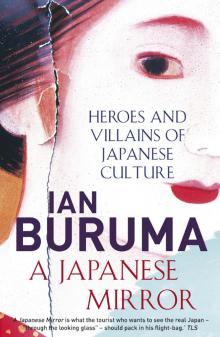 A Japanese Mirror
A Japanese Mirror Taming the Gods
Taming the Gods The China Lover
The China Lover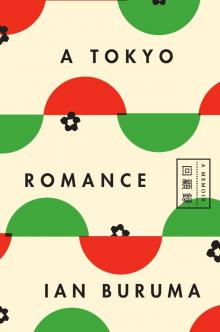 A Tokyo Romance
A Tokyo Romance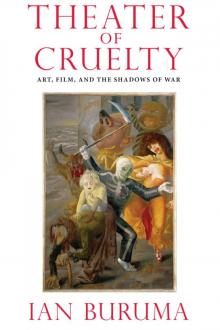 Theater of Cruelty
Theater of Cruelty Year Zero
Year Zero The Wages of Guilt
The Wages of Guilt Murder in Amsterdam
Murder in Amsterdam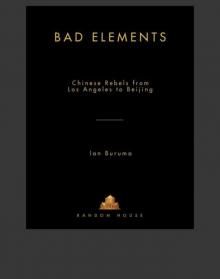 Bad Elements
Bad Elements Their Promised Land
Their Promised Land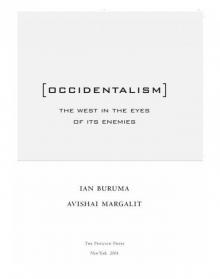 Occidentalism
Occidentalism Anglomania
Anglomania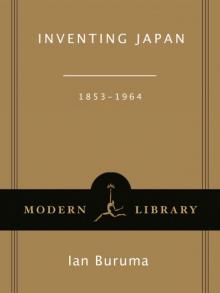 Inventing Japan: 1853-1964 (Modern Library Chronicles)
Inventing Japan: 1853-1964 (Modern Library Chronicles)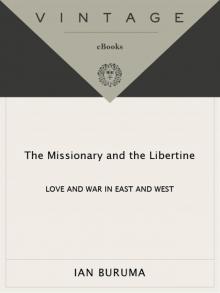 The Missionary and the Libertine
The Missionary and the Libertine